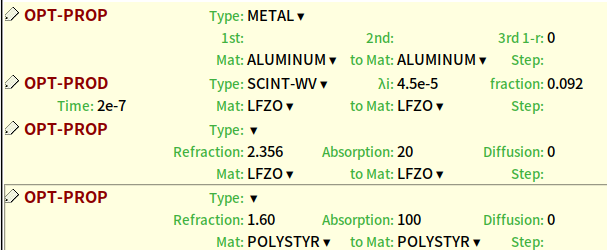Dear FLUKA experts,
1. At the card of OPT-PROP, from “Mat” to “to Mat”, so what I defined is the boundary or the two sections?
2. If the answer is boundary, may I use OPT-CARD with type=METAL and set “3rd 1-r=0” to represent light cross the boundary from “Mat” to “to Mat” will happen total reflection? If the answer is section, how should I simulate its boundary?
3. In one material section, how should I set its coefficient when it happened wavelength shifting(just like only absorb lambda a and not absorb lambda b that generated by wvlnsh.f)?
Look forward to your help.
Dear XIONG BANGPING,
The range “from material” “to material” is inclusive, meaning the card applies to the first material, the last material and the materials in between (you can also skip some of the ones in between using the option “in step of”).
On the OPT-PROP card you do not define optical boundaries, you define the properties of individual materials. If a “non-metal” material (i.e. one for which you defined an index of refraction) has a boundary with a “metal” materials, optical photons from the non-metal medium are reflected on the metal medium.
Absorption of optical photons at the boundary of metals does not trigger the WVLNSH routine. Hence you cannot simulate wavelength shifting this way. In any case that would be unphysical.
Dear@blefebvre ,
Thank you for your kindly answer.
For the 2nd question, I do not understand it clearly, so I upload a screenshot and please help me to see if it is right.

The material “LFZO” has a boundary with “ALUMINUM”. if a photon cross from “LFZO” to “ALUMINUM”, will it happen full reflection at the boundary and back to “LFZO” ?
For the 3rd question, this involved another material (POLYSTYR), it only have a boundary with “LFZO”,
the photon will shift wavelength in POLYSTYR, so how should I set its coefficient when it happened wavelength shifting(just like only absorb lambda a and not absorb lambda b that generated by wvlnsh.f)?
Hello,
The way you have set up your OPT-PROP cards is correct. Photons travelling from LFZO will be reflected on aluminum at boundaries.
To have wavelength shifting happen in POLYSTYR you must set its absorption coefficient larger than 0.0. Then, you must use the wvlnsh routine to define the properties of the new photons. If no wavelength shifting is required in LFZO, no need to do anything in particular with that material.
Dear@blefebvre ,
- In POLYSTYR, there will be two kinds of photon after wavelength shift. If photon A(450nm) generated by LFZO and travell from LFZO to POLYSTYR, then be absorbed and emit photon B(476nm), photon B continue pass by POLYSTYR and LFZO, the below screenshot showed is OK?

- If I want photon B not be absorbed in POLYSTYR, how sould I change wvlnsh.f?
DIMENSION WVSHPH (MXWSPH), DWVSHP (MXWSPH)
CHARACTER(len=4) :: NAMREG, REGLAY
SAVE REGLAY
DATA REGLAY / 'CORE' /
INTEGER IERR
CALL GEOR2N(MREG, NAMREG, IERR)
IF ( NAMREG == REGLAY ) THEN
NWVSHP = 1.
WVSHPH(1)= -4.76E-5
DWVSHP(1)= 6.30E-7
ELSE
NWVSHP = 0
END IF
Hello,
I think you have set up your card properly for your desired outcome. Whether or not a photon is absorbed in a material does not depend on the wvlnsh routine. The best for you would be to use the ABSCFF routine, called when setting the absortion coefficient to less than -99. In the routine you have access to the wavelenght of the candidate photon and the material index, which should be enough to determine if the photon has already been wavelength shifted or not. So for those photons in polystyrene with wavelenght equal to 476nm the routine would return an absorption coefficient of 0 (i.e. no absorption).
Dear@blefebvre ,
Thank you very much for your help and I have understand it.